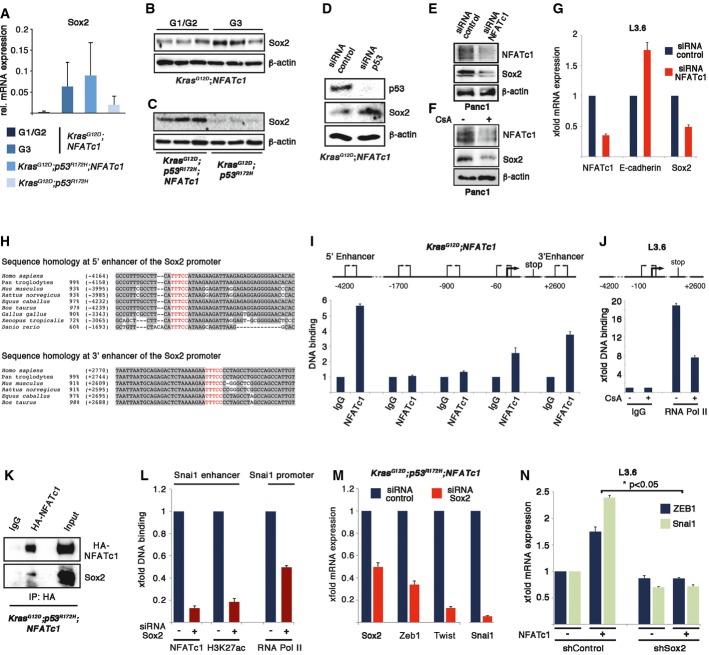Figure 5.
- Sox2 mRNA expression of pancreatic lysates from KNC, KPNC, and KPC mice, analyzed by real-time PCR in three independent experiments (means ± SD).
- Western blot analysis shows Sox2 expression in pancreatic lysates of (B) KNC mice with indicated tumor grading and in (C) KPNC and KPC mice.
- Protein expression levels after siRNA-mediated p53 depletion in KNC tumor cells.
- NFATc1 and Sox2 protein expression after (E) NFATc1 depletion or (F) upon CsA (1 μM, 24 h) treatment in Panc1 cells.
- Sox2 and E-cadherin mRNA expression after NFATc1 depletion in L3.6 cells.
- Sequence alignment of 5′ and 3′ enhancer regions show highly conserved NFATc1 binding in different species; putative NFAT binding sides within the enhancer regions of the Sox2 promoter are highlighted in red.
- ChIP assays show NFATc1 binding to Sox2 enhancer and promoter in KNC tumor cells (I) and RNA polymerase II binding to Sox2 promoter upon CsA (1 μM, 24 h) treatment in L3.6 cells (J).
- Co-immunoprecipitation of endogenous HA-NFATc1 and Sox2 was performed in KPNC cells.
- ChIP experiments show NFATc1 binding along with H3K27 acetylation (H3K27ac) mark at the selected Snai1 enhancer region and RNA polymerase II binding at Snai1 promoter in the presence or absence of Sox2 in KPNC tumor cells. Representative results from at least three independent experiments are shown (means ± SD;P < 0.05).
- Relative mRNA expression levels of EMT-related marker genes upon Sox2 depletion in KPNC tumor cells (P < 0.05).
- Zeb1 and Snail mRNA levels in L3.6 cells after shRNA-mediated depletion of Sox2 and transient overexpression of NFATc1 shows that loss of Sox2 significantly rescues NFATc1-mediated induction of EMT genes (*P < 0.05).
Source data are available online for this figure.

